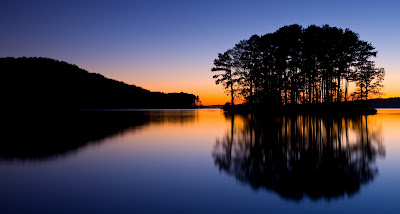(Click on the image to enlarge it.)
The shot was taken south of Pell City, AL, just below the dam at Lake Martin (Probably. If it's not Lake Martin, then it's Logan-Martin. I've never been sure. Sue me...)
Great blue herons are relatively common waders across most of North America, breeding across a wide swath of the contiguous states, as well as in southern Canda and Alaska. In my part of the world, they are easily found near any significant body of water: beaches, lakefronts, marshes, swamps, streamsides, even golf courses and wet fields...In fact, I believe that you could put out a damp rag in an Alabama back yard and a Great blue heron would turn up before the rag could dry out. Particularly impressive birds, Great blues stand nearly 4 feet tall, sport a 6-foot wingspan, and that imposing bill looks nearly a foot long. The birds are reasonably easy to approach closely, allowing for opportunities for good photography. Best places to find GBH's that are easy to approach? Go places where there are there are plenty of people around, ignoring the herons. The birds there become inured to the presence of humans.
The point of widlife photography -- to me, at least -- is to use the camera to introduce, to explain, the bird or animal to the viewer. If I'm successful, you come to know and understand the creature from seeing the photo. I am not particularly intrested in taking "mug shots" or "species shots" any longer; I want something deeper and more meaningful than that -- where you look into the subject's eyes and know what they are thinking or feeling.
Anyway, the relevant information: Nikon D700, 300mm/f 2.8 lens with a 2x tele-converter (resulting in a 600mm/f 5.6 lens.) The camera was mounted on a sturdy tripod, and I used a cable release to trip the shutter to avoid shaking the camera during the moment of exposure. I also used a flash on the shot to add contrast and catch-lights in the eyes.
The shot was taken in late afternoon, almost sunset. I like the amber tones that late-day light provides, and the absence of harsh contrasty shadows is a huge plus, as well. And to be perfectly honest, I'm just not a morning person, so I'm always looking for a justification to shoot late in the day. The Picture Control in the camera's Shooting menu was set on "Vivid" to add contrast and saturation.
Further discussion -- if you want to use a teleconverter, put the thing on a prime (non-zoom) lens. About the only zooms that work effectively with TC's are the 70-200mm/f 2.8 lenses. And regardless of the lens you put a TC on, expect to lose some optical quality. Help your situation out by stopping the lens down at least a half-stop from wide-open.

